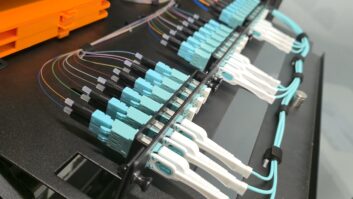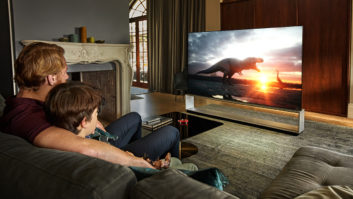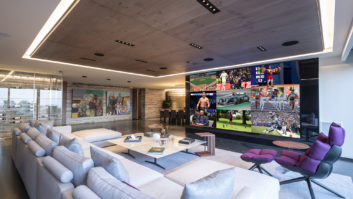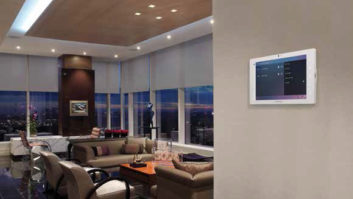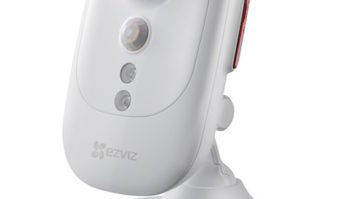It is never easy to make predictions, especially in the ever-changing consumer electronics market. But the editors of Residential Systems and TWICE put their heads together recently and came up with 18 companies, technologies, or trends to watch in 2010, based on what was revealed at the Consumer Electronics Show (CES) in January and what has been announced in recent the weeks since.
CRESTRON

During the time that its DigitalMedia and RoomView Software provided a single platform to manage and distribute HD signals throughout the Olympic sports complex in Vancouver, there seemed to be a new addition shipping for the ADMS Intermedia Delivery System and lower-cost Adagio platform every other week this winter. For Crestron’s ADMS, the new ADC-200BR 200-disc Blu-ray changer can be cascaded to hold 1,000 discs, and the CEN-NAS-4TB features four hot-swappable 1TB hard drives with RAID 5 protection. For Prodigy, the new PAMP-4X100 Processor Amplifier delivers six stereo sources to four rooms at 50 watts per channel, and can be expanded up to 12 rooms. Room volume control and source selection are available from the front panel, a PTL4 touchpanel, PLX2 handheld remote, wired or wireless audio keypads, iPhone or iPod touch.
DENON

Denon’s S-5BD BD-receiver combines a two-zone, two-source AV receiver with a Blu-ray Profile 2.0 player.
The company, celebrating its 100th anniversary in 2010, is launching the compact S-5BD BD-receiver, which combines a two-zone, two-source AV receiver with a Blu-ray Profile 2.0 player. It’s targeted for use in secondary rooms, marine applications, and hotel rooms where space is tight. The $1,799-suggested-retail component feature 1080p/24p video output, DVD video scaling up to 1080p, decoding of all Blu-ray surround formats, RS-232C port for third-party controllers, compressed-audio restorer, three HDMI 1.4 inputs/1 output, and Dolby Pro Logic IIz to deliver front-height channels. Two preouts connect to an outboard amplifier to create a 7.1-channel system featuring either surround-back or front-height channels. The BDreceiver will drive two two-channel zones or, with an add-on amp, a 5.1-channel system plus a remote two-channel zone. The S-5BD also features an SD Card slot to provide the flash memory needed to use BD Live features.
DOLBY TECHNOLOGIES
Dolby technologies of various stripes will continue to appear in multiple new products throughout the year. Sony plans to offer its first AV receivers (AVRs) with Dolby Pro Logic IIz, and Motorola will incorporate volume-leveling Dolby Volume technology in a line of cable-TV set-top boxes. In AVRs, Pro Logic IIz post-processing technology adds a pair of front-height channels to 5.1- and 7.1-channel surround systems. In cable boxes, Dolby Volume maintains a consistent perceived volume level when channels are changed and a TV program transitions to a commercial. Dolby Volume also is designed to dynamically and automatically compensate for the human ear’s lower sensitivity to bass and treble sounds as volume levels decrease, ensuring that low- and high-frequency sounds are audible when a program’s volume is automatically lowered to a user’s preset listening level. Sony also plans to launch its first AVRs with Dolby Pro Logic IIz, joining AVRs from such companies as Denon, Integra, Marantz, and Onkyo.
HDMI 1.4

LG is including Skype HD video conference capability in Internet-enabled sets this year.
Sherwood and Denon turned up at CES with the first audio components with HDMI 1.4 connections, and Onkyo said it will introduce its first HDMI 1.4-capable products in the spring. The products incorporate the initial version of the HDMI 1.4 chip, which supports an audio return channel and 3D video. Chips supporting an Ethernet stream and the 4Kx2K/24 display format, with up to four times the resolution of 1080p, won’t be available until late this year or possibly early 2010, Denon said. Sherwood’s first HDMI 1.4 products are the $499.95-suggested 7×100-watt RD-7605N and $349.95-suggested 7×100-watt RD-7605 AV receivers. The RD-7605 offers the same features as the RD-7605N but lacks its networking and AV Internet-streaming capabilities. For its part, Denon plans March shipments of its compact $1,799-suggested S- 5BD BD-receiver, which combines two-zone twosource AV receiver with Blu-ray Profile 2.0 player. It features three HDMI 1.4 inputs/1 output. Onkyo’s first HDMI 1.4 products are due in the spring, and all future AV receivers will have it, said marketing manager Paul Wasek.
LG ELECTRONICS
Like most of the major flat-panel TV brands this year, LG is making a big statement with LED technology by introducing LCD TVs based on LED back- or edge-lighting systems. Out of 11 LCD TV model series announced at CES for 2010, six will be based on LED. The company is splitting the technology between those with edge-mounted LED systems to produce thinner panel depths at lower cost, and new full array LED systems with local dimming technology that enables in some cases even slimmer panels (less than an inch deep) than the edge-lit LED sets. Ten of the company’s advanced TV series employ the company’s upgraded Netcast technology with Yahoo!’s Widget engine to deliver a range of interactive Internetbased applications to the screen. These include streaming on-demand movie and video services from partners including NetFlix (version 2.0), Vudu, and YouTube, and other features including AccuWeather.com weather alerts and Picasa online photo services. The company will also be including Skype HD video conference capability in Internet-enabled sets this year, and will be among the many major TV brands with 3D TV systems based on active-shutter glasses technology that are due later in the year.
PANASONIC
Panasonic made its leadership statement in 3D TV technology last year, when it announced a sponsorship agreement for the wildly successful 3D Sci-Fi movie Avatar. This year, the company is following through with plans to deliver its first 3D plasma sets, 3D Blu-ray Disc player, and even the industry’s first twin-barrel 3D camcorder. The company will offer a premium V Series line of full 1080p, 3D plasma sets in the 50-, 54-, 58- , and 65-inch screen sizes. Due in the spring, models in the VT25 series will ship with one pair of glasses based on an active LC shutter system. The 3D system, which Panasonic has dubbed Full HD 3D, delivers full 1080p resolution to each eye. The glasses rapidly alternate a left and right angle of an image, which the brain perceives as one stereoscopic picture. Panasonic will offer 17 Viera plasma TVs across five model series, many of which employ the company’s NeoPDP technology offering a substantial decrease in power consumption from the company’s 2007 models. Many models also include Panasonic’s VieraCast Wi-Fi technology that delivers to access over a broadband connection to Panasonic online content partners. Panasonic aalso announced that it is including Skype HD video conference capability in its Internet-enabled sets this year.
MICROMEGA’S AIRSTREAM

Micromega’s WM-10 AirStream WiFi-equipped DAC for high-end audio playback of iTunes music
Micromega of France has developed a WiFi-equipped DAC for high-end audio systems, called the WM-10 AirStream, that uses 802.11n to stream music from Apple’s iTunes app on a networked PC. An iPhone or iPod touch then can be used as a WiFi remote to select iTunes songs and playlists. Audio Plus Services will distribute the product in the U.S. and Canada. The WM-10, which features 192kHz/24-bit DACs, connects with a PC’s Apple iTunes program and natively decodes any file format that Apple’s iTunes can access, the company said. It also is compatible with Sonic Studio’s Amarra, and Rogue Amoeba’s Airfoil software.
MITSUBISHI
Having first planted its flag in the 3DTV waters several years ago by offering DLP rear-projection TVs with 3D video gaming capability, Mitsubishi is offering loyal purchasers a low-cost adapter to enable its legacy 3D products to play movies from new 3D Blu-ray Disc players due out later this year. Also look for the company to expand its Laservu DLP rear-projection TV technology with more models and screen sizes, following introductions planned for later in the year. The system employs a laser light engine instead of LEDs or UHP lamps to produce bright, richly colored images with deep black levels and lowpower consumption. The sets will also be 3D compatible.
POLK AUDIO

Polk’s new Vanishing Series in-ceiling speakers shrink their footprint without sacrificing bass output and extension by mounting an oval woofer to a steeply angled oval tube inside the ceiling.
Polk Audio has taken advantage of the recession to sharpen its focus on “solutions and applications-oriented products” with the launch of 16 new products, including active surroundbars with wireless subwoofers, smallfootprint in-ceiling speakers with large woofers, and a wireless speaker that reproduces two to four surround channels from a single cabinet. At September’s CEDIA EXPO, Polk launched its Vanishing Series of custom speakers, focusing initially on in-wall models. Six three-way in-ceiling models ship in the second quarter at $229 each to $549 each. The in-wall models, priced from $400 to $1,500 per pair, feature slim 3mm bezels and grilles that protrude from the wall only by 7mm. The micro-perf grilles feature 0.6mm hole size to look sheer from only a few feet away. The in-ceiling speakers shrink their footprint without sacrificing bass output and extension, the company said, by mounting an oval woofer to a steeply angled oval tube inside the ceiling. The woofer fires into the tube through ports that reside on a 15-degree angled baffle, where the tweeter and midrange also mounted.
RETROFIT AUDIO RACE

Russound was quickly out of stock on its Collage system in January. NuVo’s Renovia line is expected to ship in the second quarter
NuVo Technologies and Russound swear that there’s enough retrofit multi- room audio market for both of them, but the “first-to-market” competition between their Renovia and Collage powerline-based systems was hard to miss. On January 8, Russound became to first to deliver Collage’s main components include an in-wall amplified keypad equipped with RDS FM tuner. A Media Manager device connects to a home’s Ethernet network and acts as a bridge between a home’s Ethernet network and the powerline network. An iPod dock and IR source bridge, which connects legacy sources via IR, will ship sometime later. When NuVo’s Renovia ships later in Q1, the company says the system will include its full complement of source equipment, amps, and accessories. In other words, dealers will be able to install a complete system with all of its” addons” from the get go. Renovia features a Source Hub that connects via powerline to NuVo Zone Amplifiers (NVRVZA50S) in each room, that then connect to architectural or freestanding speakers in the room using speaker wire.
SAMSUNG
Samsung is offering several series of 3D-capable displays and an even larger cache of LCD TV with LED edge lighting. Among the company’s 2010 highlights is the C9000 LED HDTV series, in the 46- and 55-inch screen sizes. Both feature a panel thickness of less than an inch. The line includes Samsung’s proprietary 3D processor that supports several 3D standards, including half-resolution and full-HD formats, as well as the new Blu-ray 3D standard. The company also can process standard 2D images to produce a 3D stereoscopic effect. The set uses edge-lit LED technology and a diffuser panel to produce an even light appearance across the screen. The C9000 series, with 46- and 55-inch screen sizes, will also include Samsung Apps to perform a host of functions over the Internet. The sets will also include a touchscreen remote with integrated Wi-Fi that enables users to watch one program on the TV screen and another on the remote.
SHARP

Sharp’s new four-color technology will launch with the Aquos LE920 in May
Sharp’s new Aquos LCD TVs features Quad Pixel technology, which uses four primary colors instead of just three in each sub-pixel to generate a richer gamut of almost 1 trillion colors. It is especially noticeable in the gold and yellow ranges, because Sharp introduces a yellow subpixel to the red, green, and blue used by most other manufacturers. The technology will be found starting in May in the Aquos LE920 series, which also includes a new UV2A panel with an improvement in the alignment of liquid crystals to produce better contrast and lower energy consumption. The series will also employ LED edge lighting and a 240Hz refresh rate to yield a panel depth of 1.6 inches in the 52-, 60- and 68-inch screen sizes. The company will expand its use of LED edge lighting and 120Hz refresh rates in two additional Aquos model series, as well.
SONY
Sony jumped on the 3D technology wave by announcing plans for several lines of 3D-ready Bravia 1080p/240Hz LCD TV sets. The XBRLX900 series will offer the best of the Sony brand with LED edgelighting, Bravia Internet Video capability with integrated 802.11n Wi-Fi connectivity, 1080p resolution, a 240Hz refresh rate, and an Eco-Presence Sensor that automatically turns off the set if no one is in the room. It will include 46-, 52- and 60- inch screen sizes. For LX series models, Sony will bundle RealD active shutter glasses and IR emitters that are built into the bezel of the sets. The company will also offer 3D capability in the XBRHX900 series and the KDLHX800 series. Both include 1080p resolution and 240Hz refresh rates. The HX900 line features full-array LED backlighting with local dimming technology, while the HX800 line used edgelit LED lighting with “local dimming lite” technology to offer a slimmer profile.
SHERWOOD

Sherwood’s RD-7405HDR features streaming and HD Radio.
The company plans to launch a second AV receiver equipped to stream Internet- and PCbased media, an AV receiver with embedded HD Radio at a suggested retail of only $219.95, and its first two AVRs with HDMI 1.4 input and output. The AV receiver with HD Radio is the 7×50-watt RD-7405HDR, with a suggested retail of $219. It’s Sherwood’s first HD Radio product. The company’s second networked AVR is the $499.95-suggested 7.1-channel RD-7605N, joining the recently shipped $649-suggested 7.1-channel NetBoxx. The latter looks more like a slimline Blu-ray player than a traditional AVR. Both networked AVRs feature DLNA certification to simplify streaming from a networked PC via wired Ethernet or optional USB/Wi-Fi adapter. To stream AV content directly from the Internet, the 7605N and NetBoxx incorporate Verismo Networks’s VuNow platform, which streams video up to 720p. The 7×100-watt $499 RD-7605N and $349.95-suggested 7×100-watt RD-7605 AV receiver will be the company’s first AVRs with HDMI 1.4 connections. The RD-7605 AVR offers the same features as the RD-7605N except for networking and Internet streaming.
SPEAKERCRAFT

SpeakerCraft’s NIRV is scheduled to ship in the second quarter of 2010 with much fanfare.
Much had been made of SpeakerCraft’s attempted reinvention from in-wall speaker company to “AV integration manufacturer” following the introduction its NIRV control and automation system at CEDIA EXPO in September. The Nirv system concept has modular architecture instead of a central hub design, meaning that a dealer will only need to buy the pieces necessary for the specific system he has designed and upgrading or expanding is as simple as adding what is needed to the network. All media, data, control, and communication signals are distributed through a single Cat-5 cable making system wiring both simple and cost efficient. Beyond standard AV distribution, the system also integrates theater surround sound, home automation, and page/intercom into one package. NIRV is scheduled to ship in the second quarter of 2010 with much fanfare.
VIZIO
Vizio has risen to the top of the U.S. TV market share charts in recent years with high-value, lowmargin goods sold mainly through warehouse clubs and Wal-Mart. But this year the company is looking to expand its distribution behind a new XVT Pro LCD TV line, targeted at custom installers and local and regional AV retailers with “assisted sales floors.” To accomplish this, the company will be partnering with distributors in addition to selling direct to certain accounts. All XVT Pro models include Vizio Internet Apps (VIA) streaming Internet video access enabled by built-in HD wireless (802.11n dual-band) and wired networking, a Bluetooth universal remote control with sliding QWERTY keyboard, and interactive setup. For 3D support, the XVT Pro models will utilize Sensio 3D technology that delivers 3D content over conventional 2D infrastructure. Viewers can view compatible 3D programming wearing optional XpanD active-shutter glasses. The XVT Pro sets will present 3D in full HD 1080p video to each eye, and will accept 3D images from Sensio-encoded material on conventional DVD and Blu-ray players, as well as from future distribution sources such as pay per view, video-on-demand, and DTV and HDTV broadcasts, the company said. The highlight of the series is 72-inch 480Hz SPS TruLED Full HD3D full array LED backlighting with 480 zones of “Smart Dimming” technology, built-in wireless HDMI and Vizio Internet Apps (VIA) with HD wireless networking. The set will ship in August at a $3,499 suggested retail. The company will also carry the 58-inch Razor LED with Smart Dimming Cinema Display, featuring a 21:9 aspect ratio that enables film enthusiasts to view 2.35:1 films on a full screen (2560-by-1080 pixels) without black bars. The set also includes built-in wireless HDMI and VIA with HD wireless networking.
TOSHIBA
Toshiba took the wraps of its first Cell TVs slated for U.S. introduction later in the year. The company announced it will offer two design series for the new sets, including the ZX900 “Genesis Design” line, in the 55- and 65-inch screen sizes, and later the “Allusion Design” series in the 46-, 55- and 65-inch screen sizes. All will use the Cell processor manufactured by Toshiba and co-developed with Sony and IBM. The same chip is used to power Sony’s multi-purpose PlayStation 3 video game console. In TVs, the chip will be added for better image processing of material upconverted to 1080p high definition as well as 3D. In fact, new TriVector technology in the sets will play native 3D material from new Blu-ray Disc players and PCs as well 3D upconverted from 2D sources. The sets will also include image processing and noise cancellation to improve the look of Internet delivered HD content, which is often full of compression artifacts.
WADIA DIGITAL

The company will launch its next-generation iPod dock, which adds Works With iPhone certification, an upgraded power supply, and a remote offering with new features such as playlist and album navigation. Like its predecessor, the 171iTransport captures an iPod’s audio output as digital PCM.
